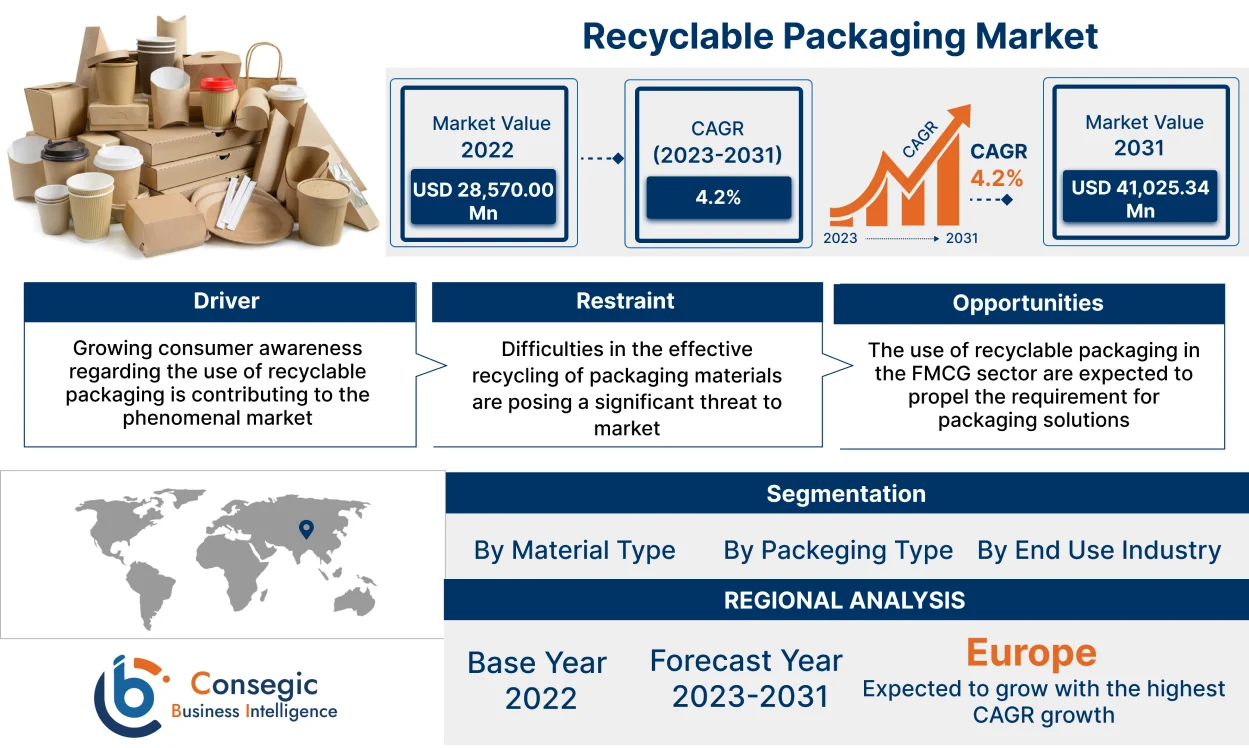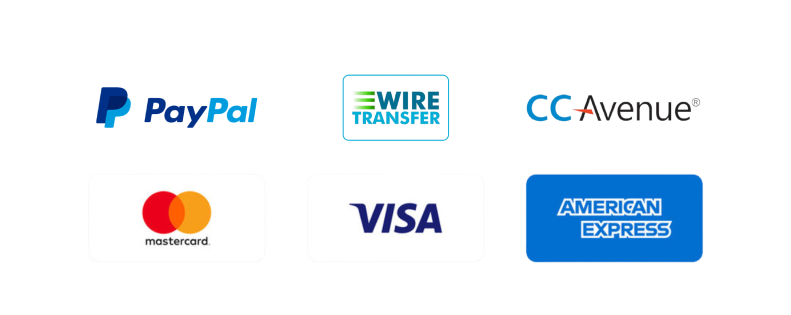Recyclable Packaging Market Scope & Overview:
Recyclable Packaging Market Size is estimated to reach over USD 46.12 Billion by 2032 from a value of USD 30.45 Billion in 2024 and is projected to grow by USD 31.64 Billion in 2025, growing at a CAGR of 4.8% from 2025 to 2032.
Recyclable Packaging Market Size :
Recyclable packaging consists of materials that can be converted into new items after their initial use, which helps lessen environmental harm and promotes sustainability. These packages are made to cut down on waste and pollution, supporting a circular economy. Their main feature includes ease of sorting, processing, and converting into new materials or products. This type of packaging includes many materials like cardboard, glass, plastics (such as PET or HDPE), aluminum, and paper.
Global Recyclable Packaging Market Insights :
Recyclable Packaging Market Dynamics - (DRO) :
Key Drivers :
Growing awareness regarding environmental issues among consumers is driving the recyclable packaging market expansion
Consumers are increasingly looking for packaging solutions that minimize environmental impact, which has led to a surge in demand for recyclable materials. This trend is further boosted by robust regulatory frameworks adopted by governments worldwide, mandating the use of recyclable packaging to reduce carbon footprints and conserve resources.
- For instance, the European Union’s Circular Economy Action Plan aims for 100% recyclable plastic packaging by 2030, which propels market growth substantially.
- Additionally, according to a report published on September 2022 from the United States Department of Agriculture, Zero Waste was identified as one of Germany's top five consumer trends for 2022-2023. The report also indicated that over two-thirds of German consumers are urging companies to adopt environmentally conscious practices.
Thus, according to the recyclable packaging market analysis, the growing awareness regarding environmental issues among consumers is driving the recyclable packaging market size.
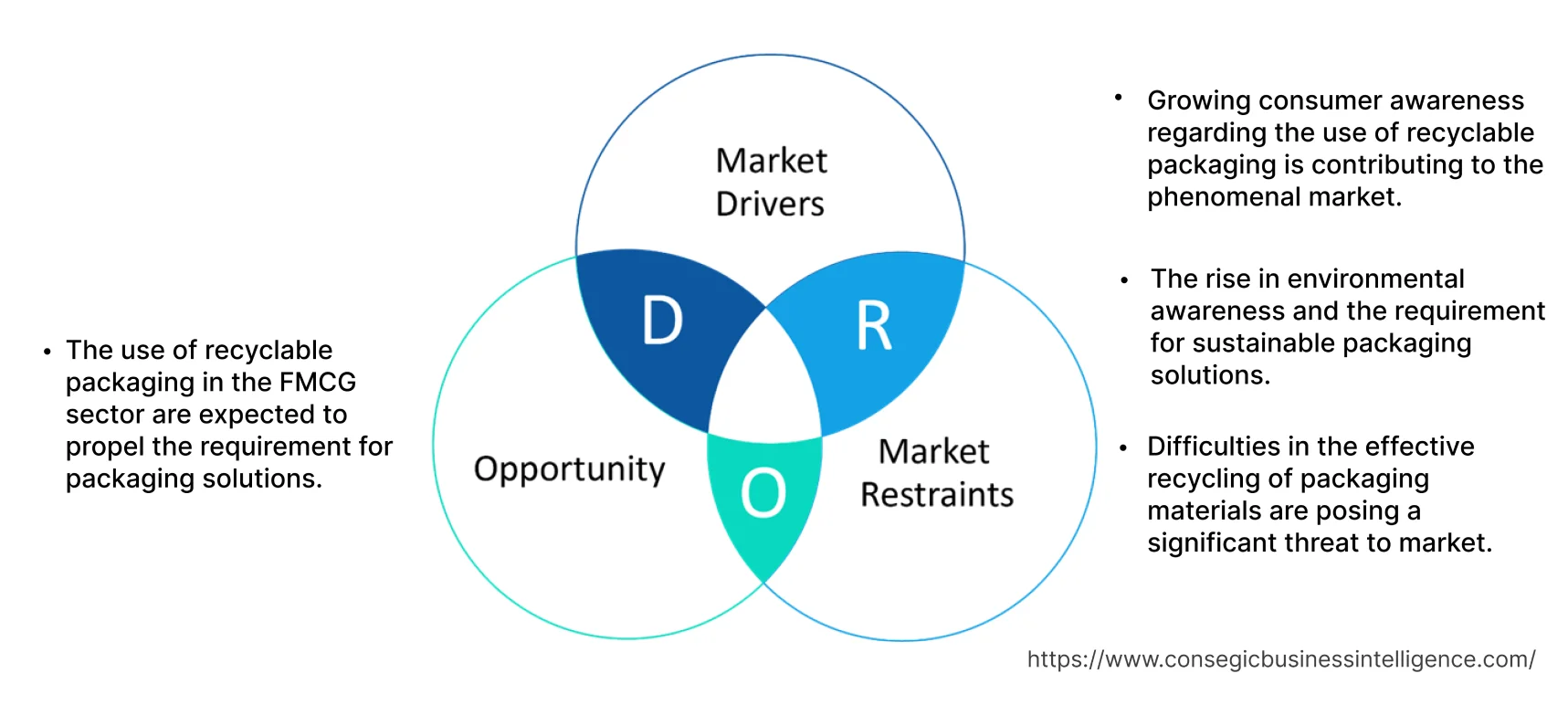
Key Restraints :
High cost associated with the development and implementation of sustainable packaging solutions are affecting the recyclable packaging market demand
The production and recycling of recyclable materials can be more expensive than traditional materials, posing a challenge for companies looking to adopt sustainable packaging solutions. Switching to recyclable materials or new eco-friendly packaging can be pricier than using traditional options due to the specialized processing and equipment needed. This higher cost often discourages some companies, particularly those on tight budgets, from fully adopting these more sustainable packaging solutions. Therefore, the aforementioned factors would further impact the recyclable packaging market.
Future Opportunities :
Increasing adoption of recyclable and sustainable packaging in fast moving consumer goods sector is expected drive the recyclable packaging market opportunities
Fast-moving consumer goods (FMCG) are products that are usually sold quickly and at a fairly lower price, encompassing items like household goods, food, beverages, and home care products. The long-term use of recyclable and sustainable packaging in this sector offers cost benefits. Moreover, growing consumer awareness about environmental well-being is driving up demand for sustainable packaging solutions for these products. The ongoing development of the FMCG sector is anticipated to further increase the need for such packaging, thereby boosting the market.
- For instance, according to the India Brand Equity Foundation (IBEF), the Indian fast-moving consumer goods (FMCG) market was valued at USD 56.8 billion as of December 2022. This market is projected to experience significant development, with total revenue expected to increase at a compound annual growth rate (CAGR) of 27.9% from 2021 to 2027, reaching approximately USD 615.87 billion. This substantial expansion in the FMCG sector is further anticipated to drive a greater need for sustainable packaging throughout the forecast period and boost the growth of the recyclable packaging market share.
Thus, based on the above recyclable packaging market analysis, the above factors are expected to drive the recyclable packaging market opportunities.
Top Key Players & Market Share Insights :
The global recyclable packaging market is highly competitive with major players providing solutions to the national and international markets. Key players are adopting several strategies in research and development (R&D), product innovation, and end-user launches to hold a strong position in the market. Key players in the recyclable packaging industry include-
- Amcor plc (Switzerland)
- Emmerson Packaging (Canada)
- Sealed Air Corporation (U.S.)
- WestRock Company (U.S.)
- DS Smith (U.K.)
- DuPont (U.S.)
- Mondi (U.K.)
- Bemis Company (U.S.)
- Tetra Laval (Switzerland)
- Ardagh Group SA (Luxembourg)
- Emerald Packaging (U.S.)
- Nampak (South Africa)
- JBM Packaging (U.S.)
- Smurfit Kappa (Ireland)
- GWP Group (U.K.)
Recyclable Packaging Market Segmental Analysis :
By Material Type :
Based on material type, the market is segmented into paper, wood, plastic, glass, metal, and others.
Trends in the material type:
- The development of packaging that integrates multiple recyclable packaging materials to achieve optimal performance while maintaining sustainability is an emerging trend in the segment.
- Materials, such as biodegradable polymers and composite materials, are gaining traction as industries look for more sustainable packaging solutions, thereby driving the recyclable packaging market growth. These materials often combine the benefits of traditional materials with enhanced environmental performance.
- Thus, the above analysis and factors are driving the recyclable packaging market demand.
The paper segment accounted for the largest revenue share of 40.34% in the year 2024.
- Paper dominates the market due to their biodegradability and ease of recycling. These materials are extensively used in manufacturing corrugated boxes, cartons, and other forms of packaging.
- The increasing adoption of e-commerce has led to a surge in the need for paper-based packaging as they are lightweight, cost-effective, and environmentally friendly.
- Innovations in paper technologies, such as water-resistant paper and enhanced durability, are further driving their usage across various industries, including food & beverage and healthcare among others.
- Thus, based on the above analysis, these factors are further driving the recyclable packaging market growth.
The plastic segment is anticipated to register the fastest CAGR during the forecast period.
- Plastic, despite its environmental concerns, remains a critical segment due to its versatility and cost-effectiveness.
- Advances in recycling technologies have led to the development of high-quality recycled plastics that can be used in packaging applications, from bottles to pouches.
- Companies are also investing in chemical recycling processes to convert plastic waste into reusable raw materials, thus creating a circular economy.
- For instance, in October 2023, Coca-Cola launched its cola brand in new rPET bottles, available in 250 ml and 750 ml sizes. The company stated that these bottles are made entirely from 100% food-grade recycled PET, excluding the caps and labels, aiming to boost consumer awareness about sustainable packaging.
- Thus, the above developments are expected to drive the recyclable packaging market share and trends during the forecast period.
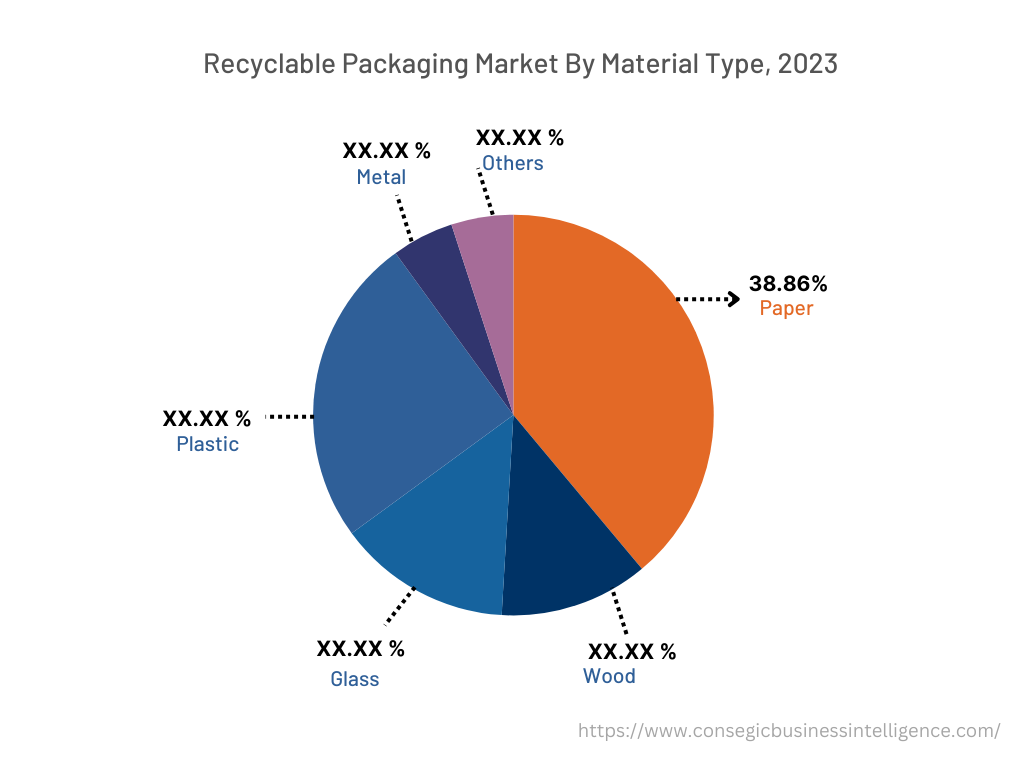
By Packaging Type :
Based on packaging type, the recyclable packaging market is segmented into flexible and non-flexible.
Trends in the packaging type:
- The focus on reducing the environmental footprint of packaging is driving the adoption of recyclable materials across various packaging formats.
- Companies are investing in developing innovative recycling processes and materials to enhance the recyclability of these packaging types.
- Based on the above analysis, these factors are anticipated to further drive the recyclable packaging market trends during the forecast period.
The flexible segment accounted for the largest revenue share in the year 2024 and it is expected to register the highest CAGR during the forecast period.
- Flexible packaging consists of materials that can adapt to the shape of the product they contain.
- This type of packaging helps reduce product damage because it is easily molded, allowing for convenient storage.
- Moreover, flexible packaging is highly customizable, cost-effective, lightweight, and keeps products fresh longer.
- It is also more sustainable since many of its materials are recyclable and compostable. The growing use of flexible packaging by companies is expected to drive up its demand.
- Thus, based on the above analysis, these factors would further supplement the recyclable packaging market trends.
By End Use Industry :
Based on end use, the recyclable packaging market is segmented into food and beverage, pharmaceuticals, cosmetics and personal care, and others.
Trends in the end use:
- The need for sustainable packaging solutions across various sectors is driving the need for recyclable materials. Companies are investing in developing innovative packaging solutions that meet sustainability criteria while ensuring product protection and functionality.
- Companies are adopting sustainable plastic packaging solutions to meet consumer needs and comply with regulations. Innovations in packaging design and materials are enhancing the recyclability of packaging for household products.
The food and beverage segment accounted for the largest revenue share in the year 2024.
- The food & beverage sector is the largest end-user of recyclable packaging, driven by the need for sustainable packaging solutions that preserve product quality while minimizing environmental impact.
- The demand for recyclable packaging in this sector is fuelled by increasing consumer awareness and stringent regulations.
- Moreover, companies are adopting recyclable materials for packaging to meet sustainability goals and enhance brand image.
- Additionally, innovations such as plant-based plastics and compostable packaging are gaining traction in this industry.
- Thus, the above factors and developments are driving the global market.
The cosmetics and personal care segment is anticipated to register the fastest CAGR during the forecast period.
- The personal care & cosmetics industry is witnessing a growing need for recyclable and sustainable packaging solutions. Consumers are increasingly seeking eco-friendly products, including sustainable packaging.
- Moreover, brands are responding by adopting recyclable materials such as glass, aluminum, and bio-based plastics for packaging.
- Further, the rising trend towards premiumization and inclusion of natural products in the personal care & cosmetics sector is further driving the adoption of recyclable and sustainable packaging.
- Thus, based on the above analysis, these developments are expected to drive the global
Recyclable Packaging Market Report Insights :
| Report Attributes | Report Details |
| Study Timeline | 2019-2032 |
| Market Size in 2031 (USD Million) | USD 46.12 Billion |
| CAGR (2023-2031) | 4.8% |
| By Material Type | Paper, Wood, Glass, Plastic, Metal, and Others |
| By Packaging Type | Flexible and Non-flexible |
| By End Use Industry | Food and Beverage, Pharmaceuticals, Cosmetics and Personal Care, and Others |
| By Region | North America, Europe, Asia Pacific, Latin America, and Middle East & Africa |
| Key Players | Amcor plc, Emmerson Packaging, GWP Group, Logos Pack, Swisspac Packaging, Tetra Laval, Ardagh Group SA, Better Packaging Co., Ball Corporation, Elopak AS, Emerald Packaging, PlastiPak Holdings Inc., Sealed Air Corporation, WestRock Company, Be Green Packaging, DS Smith, DuPont, Mondi, Bemis Company, Nampak, JBM Packaging, and Smurfit Kappa |
By Region :
The global market has been classified by region into North America, Europe, Asia-Pacific, Middle East & Africa, and Latin America.
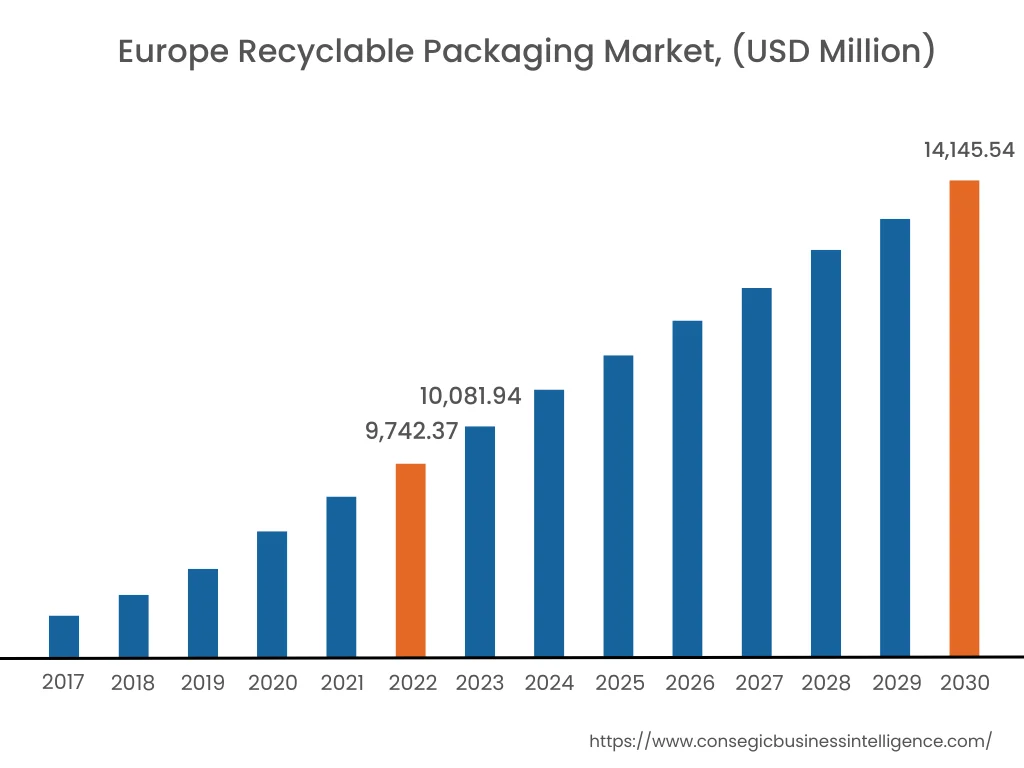
Asia Pacific recyclable packaging market expansion is estimated to reach over USD 10.15 billion by 2032 from a value of USD 6.28 billion in 2024 and is projected to grow by USD 6.56 billion in 2025. Out of this, the China market accounted for the maximum revenue split of 39.23%. The regional growth can be attributed to rapid urbanization, industrialization, and increasing consumer awareness about environmental issues. Countries in the region are implementing policies to reduce plastic waste and promote sustainable practices. Further, the growing middle class with higher disposable income is increasingly seeking eco-friendly packaging solutions, in turn propelling market growth in the region. These factors would further drive the regional recyclable packaging market during the forecast period.
- For instance, in June 2022, the Public Information Bureau reported that India implemented a nationwide ban on the manufacturing, importing, stocking, distributing, selling, and using certain single-use plastic items. This ban specifically targets items with low utility and high potential for littering. The above factors are expected to drive the adoption of recyclable and sustainable packaging, in turn boosting the market in the Asia-Pacific region during the forecast period.
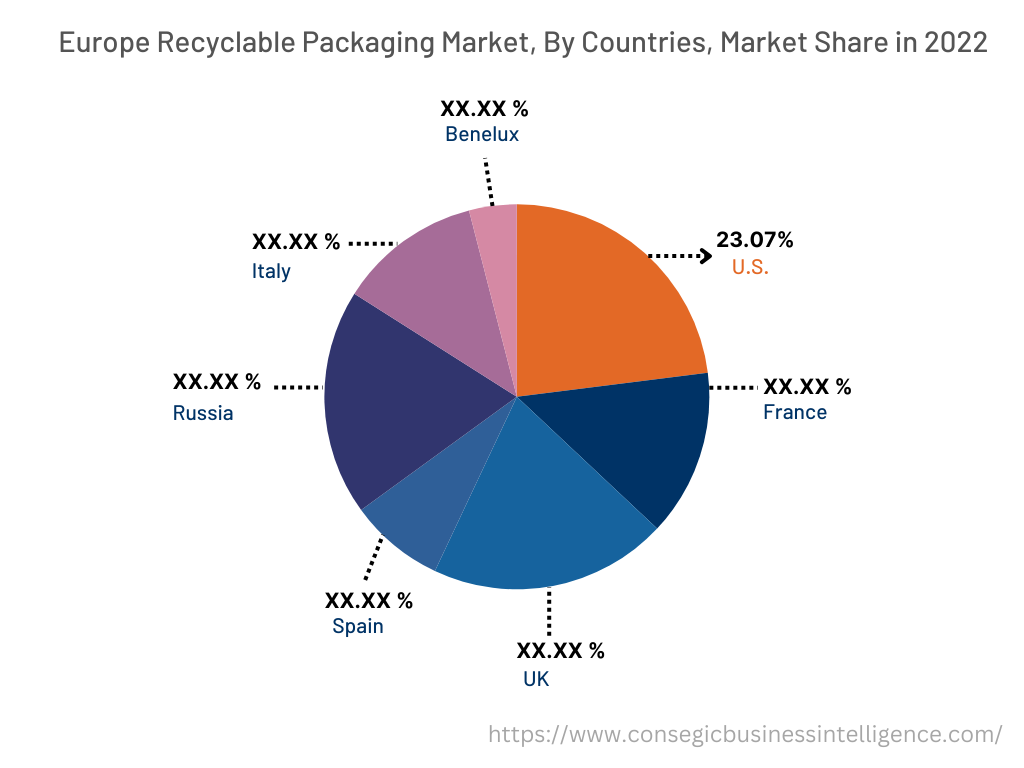
Europe market is estimated to reach over USD 20.94 billion by 2032 from a value of USD 13.88 billion in 2024 and is projected to grow by USD 14.40 billion in 2025. Europe is another major market for recyclable packaging, with countries such as Germany, France, and the United Kingdom leading the adoption of sustainable packaging solutions. The European Union’s Circular Economy Action Plan aims to make all plastic packaging recyclable by 2030, driving the demand for recyclable and sustainable packaging in the region. Further, the increasing consumer preference for eco-friendly products and strong corporate commitments to sustainability are also contributing to market growth. These factors would further drive the regional market during the forecast period.
Additionally, according to the analysis, the recyclable packaging industry in North America is expected to witness significant development during the forecast period. North America is expected to hold a significant share of the recyclable packaging market, driven by strong regulatory support and high consumer awareness regarding environmental sustainability. The United States and Canada have implemented stringent regulations to reduce plastic waste and promote the use of recyclable materials.
Additionally, the booming e-commerce sector in Latin America necessitates packaging solutions that are durable for transit, while driving the need for recyclable paper packaging, and flexible packaging. Further, manufacturers in the Middle East & Africa region are focusing on lightweight, optimized package dimensions, and using less material overall to reduce environmental impact. These factors are driving the regional recyclable packaging market size.
Recent Industry Developments :
Product Launch:
- In February 2024, Tetra Pak introduced new carton packaging that includes certified recycled polymers. This step supports the Indian Ministry of Environment, Forests & Climate Change's Plastic Waste Management Rules 2022 which mandates the use of recycled content. The recycled polymers utilized in Tetra Pak's packaging are certified by ISCC PLUS, a widely recognized sustainability certification system.
Key Questions Answered in the Report
What was the market size of the recyclable packaging market in 2025? +
In 2025, the market size of recyclable packaging was USD 28,570.00 million.
What will be the potential market valuation for the recyclable packaging industry by 2032? +
In 2032, the market size of recyclable packaging will be expected to reach USD 41,025.34 million.
What are the key factors driving the growth of the recyclable packaging market? +
Increasing environmental awareness and the demand for sustainable packaging solutions are driving the recyclable packaging market. Growing consumer awareness regarding the use of recyclable packaging is fuelling the market growth.
What is the dominant segment in the recyclable packaging market for the material type? +
In 2025, the paper segment accounted for the highest market share of 38.86% in the overall recyclable packaging market.
Based on current market trends and future predictions, which geographical region is the dominating region in the recyclable packaging market? +
Europe accounted for the highest market share in the overall market.
